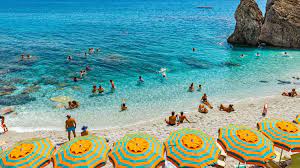Best time to visit Italy for dolomite adventures, truffle festivals and coastal escapes

Rome: Italy, the leading light of exotic holidays, has long been a treasured escape for tourists. From the iconic settings of films like The Roman Holiday (1953) and Eat Pray Love (2010) to the architectural wonders, Venetian canals, coastal splendours, and mountainous landscapes, Italy stands as a perennial crowd-favourite. The question then arises – what is the best time to visit Italy? Should you bask in the sun on bustling beaches, or opt for a quieter experience with fewer crowds and budget-friendly prices?
To assist you, we’ve undertaken meticulous research to curate a comprehensive guide on the best times to visit Italy, considering factors like crowd size, weather conditions, price points, and accommodation availability. Explore our insights for a well-informed and tailored Italian getaway.

Italy experiences delightful weather marked by various levels of warmth. The European bolt takes its predominantly rain-free summer seriously, with temperatures soaring to over 100 degrees in southern cities like Rome and Naples. If you prefer to avoid the scorching sun, it’s best to avoid the months of July and August. However, if you’re visiting Italy during the summer, consider exploring the northern cities of Venice, Bologna, and Milan, or perhaps Lake Como, for relatively milder summers (June, July and August) drifting between 60 and 70 degrees.
For those seeking southern sun and sightseeing, late spring and early fall offer balmy beaches and warm days perfect for relaxing by the sea. The months of May and September boast temperatures in the 70s and 80s, making it ideal for walking tours of historic towns, sunbathing, and swimming.
These pleasant months are also sprinkled with a host of fun-filled festivals. Bookmark important events like one of Italy’s most important literary festivals Festivaletteratura (September 4-8, 2024), Europe’s largest comics festival Lucca Comics & Games (October 30 to November 3, 2024), and Italy’s most important truffle festival, the Fiera Internazionale del Tartufo Bianco di Alba (October to December, 2024).
The lapping waves and pristine views of Tuscany, Sicily, the Amalfi Coast and Positano (among other sandy escapes in Italy) need no introduction. To experience the best weather for indulging in the Italian beach experience, consider spring, summer and autumn. However, this is common knowledge, leading to both tourists and locals flocking to the beaches, resulting in steep beach-bed rentals and bustling shacks. Nonetheless, late spring (end of April to May) offers a chance to enjoy quieter beaches, find easy and affordable accommodation in rural areas, and revel in blissful nature reserves. Explore lesser-commercialised stretches in smaller villages like Terlizzi in Puglia.
Italy has been actively promoting sustainable tourism in regions like Liguria, Umbria, Sardinia, and Abruzzo, offering picturesque cycling trails and hiking opportunities. These regions are best explored during the late spring months. Consider adding Ischia, the largest island in the Campania region’s archipelago, to your itinerary for an Italian getaway during this time. This volcanic complex is tailor-made for adventurous treks in mild temperatures.
For a honeymoon or a romantic escapade, the best time to visit Italy is from May through June and September to October. Early October presents slightly warm seas, ideal for season-end dips in the water, romantic afternoons of horseback riding amid vineyards, and savouring the season’s first white truffles. Spruce up the fun by signing up for a private yacht tour around La Maddalena archipelago in the Tyrrhenian Sea, best enjoyed in September due to pleasant weather and scantier crowds.
May and June are a good time to rev up the adventure (think hiking and mountain biking) by heading to the Dolomites, a UNESCO-designated landscape. Additionally, May hosts the annual Concerto del Primo Maggio in Rome, one of Europe’s largest free music festivals on May 1, 2024.
When it comes to budgeting in Italy, the golden rule is simple: prices rise with the influx of tourists. For a cost-effective vacation, we recommend targeting the off-season, spanning from October to April. During this period, flights and hotels can be booked at reduced prices, with some opportunities for excellent deals on guided tours. To prevent breaking the bank during peak seasons, keep an eye on flight deals in advance, consider cruise packages, and explore smaller towns and villages for a more wallet-friendly experience.
For an adrenaline-packed adventure in Italy, plan your visit from mid-April to May or from mid-September to mid-October. Lake Como, a paradise for adventure seekers, offers activities like kite surfing, sailing, para-gliding, biking expeditions, tree-top trekking, zip-lining, and cave exploration. The Dolomites, a UNESCO World Heritage Centre with 18 peaks reaching up to 3,000 metres, provide a world of adventure. In this mountainous area of the Northern Italian Alps, explore well-marked hiking trails, cycle through the valleys, go skiing, and choose to raft, all best experienced between May and June.
July and August mark the peak tourist season in Italy. In addition to the sweltering heat, popular historical sites, museums and galleries are overcrowded, leading to long queues and limited opportunities to soak up the beauty of the surroundings. August also sees many Europeans on holiday, resulting in the closure of numerous family-run establishments. For a more pleasant experience, we recommend consulting with a travel advisor before chalking out an itinerary in July.
The best time to visit Italy for adventure activities is mid-April to May, and from mid-September to mid-October.
The best time to visit Italy for a solo trip, especially for good weather and fun-filled festivals, is between April and May, as well as September to October.
To avoid extreme temperatures, especially the sweltering heat during July and August, we recommend visiting Italy from April to June, and September to October.





